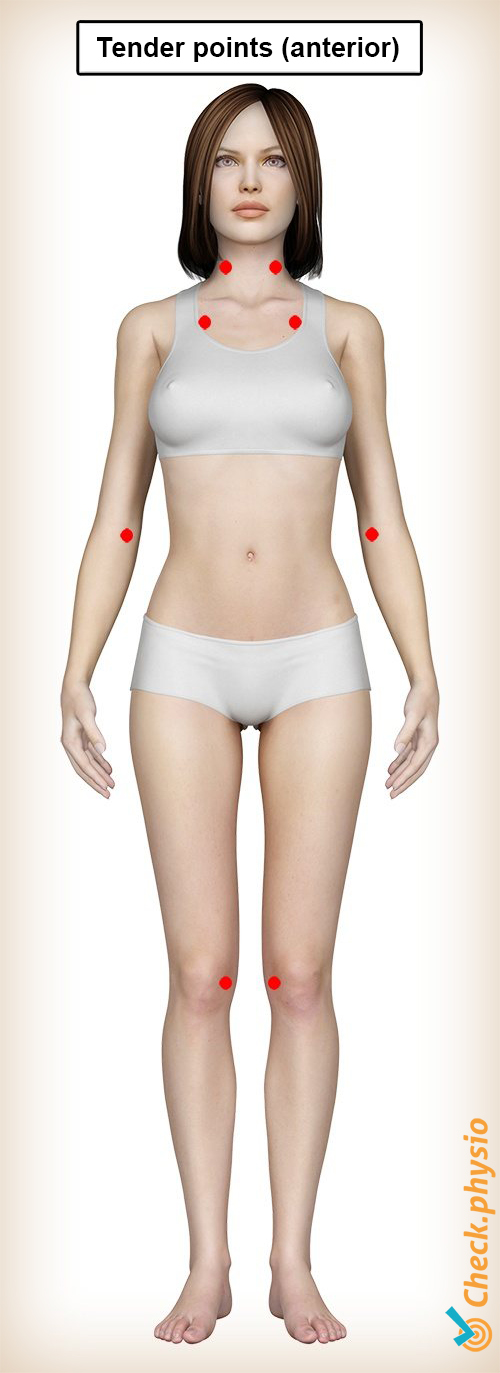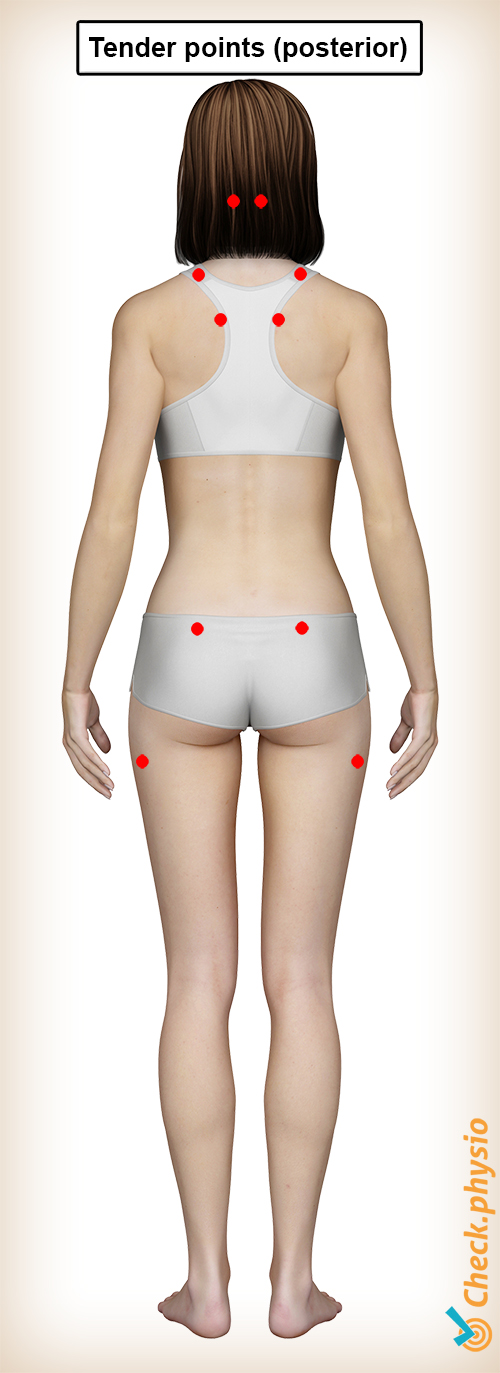Fibromyalgia
Soft tissue rheumatism / Fibromyalgia / FM
Fibromyalgia involves pain in connective tissue and muscles. It is unclear what causes these symptoms, making it difficult to diagnose. Patients often feel misunderstood and are left with unexplained symptoms.

Anyone can get fibromyalgia. However, it is more commonly seen in women. Fibromyalgia usually presents itself between the ages of 25 and 40 and occurs in approximately 2% of adults.
Description of the condition
Fibromyalgia can cause a variety of symptoms, such as pain, stiffness and fatigue. These complaints originate from muscles and connective tissue surrounding muscles and joints. Complaints from fibromyalgia are chronic. They have existed for a long time and are often or always present.
The tender points (pain points) are obvious. These are 18 spots that appear symmetrically on the body and are painful when pressed. The number of tender points can vary over time.
It is not clear what causes the complaints. For this reason, it is not possible to cure the condition with medication. However, with the right medication and lifestyle rules, the symptoms can be reduced.
The severity of the symptoms can vary greatly from one moment to another. Fibromyalgia is often mentioned in the same breath as other rheumatic disorders. In contrast to osteoarthritis or rheumatoid arthritis in which clear physical abnormalities are visible, these are absent in fibromyalgia.
Cause and origin
An exact cause for the onset of fibromyalgia has not yet been found. However, it is known that it is not hereditary and that the disease does not cause physical damage. A lot of research is being conducted into finding the cause to offer better treatment to people with fibromyalgia.
There are a number of possible explanations for the complaints. It is known that the complaints are not caused by abnormalities of the muscle tissue itself, but possibly by the brain. The brain controls all kinds of random and involuntary processes in our body. Think, for example, of consciously tensing muscles or the automatically regulated heart rate. In this, the brain works together with hormone glands and the immune system. Complaints could possibly arise if something goes wrong here.
Another cause may be in the processing or selection of stimuli. This means that normal, harmless stimuli are perceived by the body as pain stimuli.
Signs & symptoms
The complaints experienced by people with fibromyalgia can be very extensive and be more intense from one moment to another. Complaints that may occur to a greater or lesser degree are:
- Pain all over the body.
- Presence of tender points (see images).
- Loss of strength.
- Stiffness of muscles and joints.
- Sleeping problems.
- Fatigue.
- Mood problems.
- Difficulty concentrating.
- Bowel problems.
- Weather sensitivity.
Diagnosis
Because symptoms in fibromyalgia are often vague and are also seen in many other conditions, making a diagnosis can be difficult. This is why people with fibromyalgia often walk around with symptoms for a long time, without knowing what is going on.
No abnormalities are found in the blood, on X-rays or on an MRI. Therefore, the condition cannot really be diagnosed objectively. However, these examinations can be used to rule out other conditions. For this reason, it may be useful to be referred to a rheumatologist.
A number of guidelines have been drawn up for diagnosing fibromyalgia. This can be done in various ways:
Method 1
There must be pain and/or stiffness present in several places in the body. These symptoms must be present for more than three months, both above and below the waist and occur on the left and right side of the body. Eighteen tender points have been identified over the entire body. Fibromyalgia patients must have at least 11 of these.
Method 2
Pain score
The pain is scored in 19 different places of the body. One point is counted for each painful area.
Symptom score
In addition to the pain score, there is also a symptom score. With regard to the symptom score, the patient grades the level of fatigue, not waking up rested and difficulty thinking and concentrating. All additional symptoms that someone experiences are then added to this. This may include abdominal complaints, headaches, reduced appetite, etc.
With the help of the above scores, a total score is calculated. The higher the score, the more likely fibromyalgia can be diagnosed
Treatment
Because the symptoms are invisible and difficult to measure, fibromyalgia is often seen as a condition that is 'in your head'. Fortunately, this is increasingly changing. The doctor, therapist and the environment taking the symptoms seriously is an important first step in the treatment of fibromyalgia. The condition itself will progress differently in everyone and often shows an alternating character of better and worse periods.
Unfortunately, there are no therapeutic treatments or medications that offer a cure. The patient will therefore have to find a way, together with his or her environment, to deal with the symptoms as well as possible.
There are, however, a number of options that can alleviate the consequences of fibromyalgia. For instance, in consultation with the (general) practitioner, painkillers or sleeping pills can be used.
The physiotherapist helps the patient move better and regain positive experiences with this. During treatment, the large muscle groups and the endurance are trained according to the graded activity principle. The activities are gradually built up in time, number or severity. Relaxation exercises are also an important part of the treatment. In addition, heat, for example infrared, can provide relief.
It can be nice for the patient to talk to someone, like a psychologist, about how the condition impacts daily life.
Exercises
Follow the specially compiled exercise programme with exercises for Fibromyalgia here.
You can check your symptoms using the online physiotherapy check or make an appointment with a physiotherapy practice in your area.




